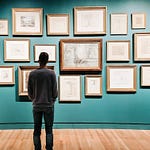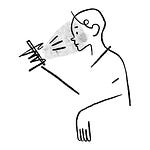Visiting yours regularly is a passport that opens your eyes and hearts to the world beyond your front door, one of your best hopes against tyranny, xenophobia, hopelessness, despair, anarchy, and ignorance.
Tsh’s free weekly email, 5 Quick Things
Go to Rothys.com/goodlist to get your new favorite flats.
This is The Good List — I’m Tsh Oxenreider.
This is a habit.
Versions of these rooms are both humble and unbelievably ostentatious, and they’ve been around since recorded history. And actually, they are the recorded history. Meaning, these places are usually the reason we even have said recorded history. Here’s what I mean.
A temple in Babylonia dating from the first half of the 3rd millennium BCE was found to have a number of rooms filled with clay tablets, suggesting an early version of this, and similar collections were found in Egypt.
In ancient China, an emperor from the Ch’in dynasty ordered that objects from this sort of place be destroyed so that history might be seen as beginning with him. This was lifted in the Han dynasty, recovering said objects and encouraging both record-keeping and classification.
Most of the larger Greek temples seem to have had these rooms, especially during the 4th century BCE with the great schools of philosophy.
Excavations in ancient Rome have revealed these in private houses.
And in the East, it was in Constantinople where Constantine the Great’s order for 50 copies of the Christian scriptures was carried out, thus needing a place to house them.
In the Islāmic world, there were those in Baghdad, Cairo, Alexandria, and Spain, where there was an elaborate public system in Córdoba, Toledo, and Granada.
As European monastic communities began, rules were laid down for several monastic orders to have one of these places for reading and study, and for someone to issue the items and take daily inventory of them.
In 13th, 14th, and 15th century Europe, we saw the development of more private versions of these among the wealthy, as well as in Islamic cultures as early as the 9th century.
By the 17th and 18th centuries, the idea of these places being a necessity became more widespread. The motive was sometimes to show off, but not always. There often was a genuine love of what was inside. This is when we see the explosion of “national collections,” where these places become more nationalistic and even revolutionary. Some overthrowers of governments saw these places as key parts of their strategy, burning what was inside in order to carry out a new way of government.
On July 1st, 1731 Benjamin Franklin and a group of his friends self-named the Junto Club created what they called The [Blank] Company. In the 1700s in Pennsylvania these things were prohibitively expensive, so you had to travel to New York or Boston, which meant only the clergy and the wealthy had access to books. The idea to create a lending library started during their Club gatherings, where each member would bring books of their own to share with others and consult during debates — but bringing books back and forth became cumbersome. They all agreed to keep the books in the meeting room (which was above a neighborhood pub) so that everyone would benefit from them. For a small fee, they could borrow a book and bring it home to read — and some people say this was the inception of the idea of starting a public subscription-based library. Franklin’s goal was to benefit more everyday people who otherwise would not have access to these hard-to-get books.
And by the middle of the 19th century, it was starting to be accepted that community versions of these places — available for free to the public — might be a good idea. This is when we saw the development of logical organization to cataloging collections, complete with a code of rules. So by the 20th century, there was a complete paradigm shift in thinking about these places, and why they mattered. And of course, as technology shifted radically in the last century, these community centers became beacons of knowledge, connection, scholarship, and development — for universities, cities, governments, leaders, and most importantly for this episode: neighborhoods.
Yep, I’m talking about the community public library. And I think making a habit of visiting yours regularly belongs on the Good List.
They’re an indispensable part of community life: they promote literacy, books for all ages (obviously), and hubs for information services. And although the practice of public libraries has been around since ancient times, this revolutionary idea was not without widely accepted without considerable opposition, that this is a good use of public funds. And even today, these fantastic, humble beacons of light throughout the world are continually under threat of closure.
And while yes, we should care about that and support good work done in our local worlds, I believe there’s so much more to gain both personally and in our family units when we make regular library visits a mainstay habit in our lives.
That brief history of libraries I told you about (which is largely found in Brittanica’s Online Encyclopedia, which I’ll link to) is fascinating, yes, but those expansive, ostentatious famous collections don’t really affect us day-to-day. It’s our unassuming public libraries I’m singing the praises of here in this episode. I’ll tell you why I think the habit of visiting yours regularly is important, why I think you should feel this way too, and practical ways to make it part of your life, after this short break. Be right back.
Welcome back. Okay, so ....public libraries. Why am I nerding out about them so hard? Most of us live near-ish one, even if you don’t exactly know where yours is. It may be tiny and perhaps unimpressive with its collection, or it might be so huge you could spend a day there and not see it all. But all of them provide the same idea to its communities: it’s a place that houses books and other recorded information. You get the gist, and if you went to public school in the 80s and 90s you remember being taught how to use your school’s: look up an author, or title, or subject (maybe in the card catalog, these days via computer), find a book or two on the topic, then use the dewey decimal system to find said books. Choose a few, check them out (either by old-fashioned card-and-stamp, or by computer), and then away you go. Return them by their due date, then rinse and repeat.
So, libraries: not rocket science, not something you’ve never thought of before. So why do I think visiting one regularly is worthy of being on the Good List? Here’s a few reasons why:
They’re cheap! Seriously. They’re one of the only places in our consumer-driven culture where you can go and you’re not expected to spend money. You can go there without two dimes to rub together, and you are welcome. You can stay all day, in fact, and no one should mind one bit. I read on Twitter not too long ago about how someone’s local library was under threat of closure because community members were complaining that there were too many homeless people hanging out there. And this tweeter had an excellent response: Um, isn’t that largely the point of libraries? You can be anybody, no matter your economic status, and be there. Because the things available in said library are free for the public to use.
Speaking of — libraries are one of the only places in a community where you’ll see people of all sorts mingling together: rich, poor, young, old, and everyone in between. In my neighborhood library we’ve got our large teen section right next to the large print new releases, and I love seeing teenagers reading just a few feet away from senior citizens.
They’re a great source of information, specifically books. And if you’re a bookworm, or you want to read more books, going to your local library is an invaluable tool at your disposal. Books can add up, so checking out library books regularly allows you to read more without spending more (which, if you’re wondering, because I used to: we authors are mostly more than okay with this, and book sales aren’t in competition with libraries — so if you love an author, request their book at your local library! More on this soon.). And if your library’s selection is less than noteworthy, visiting regularly tells them its community wants to use their collection — it’ll give them incentive to budget more for more variety.
They’re about so much more than books! You usually can check out so much stuff beyond books: movies are common, but some libraries also lend power tools, board games, and toys for little kids. My library has an aisle of puzzles (which I’ve never been brave enough to use; we lose pieces of our own puzzles at home), and also cake pans — which is brilliant! Most of us don’t need to buy a Thomas the Tank Engine or Elmo cake pan for our permanent kitchen collection, but it’s handy to borrow one when it’s your kid’s birthday. I think that’s such a great idea.
And beyond lending, libraries provide so many other resources. This month one of my sons is going to check out our library’s monthly D&D club for teens, so he can find his fellow neighborhood nerds. There’s also a knitting club that meets at ours: I loved when we first moved to this area and I saw a group of older women sitting in a circle with younger people; I saw a grandma teaching a 20-something guy how to cast on. There are usually lectures about various topics, traveling exhibits (ours had a really amazing one last year about people and families who hid Jews in Europe during the Holocaust), local art on display, movie nights, baby and toddler storytimes, and author events. Some of my personal favorite events as an author have been in libraries! And community libraries provide services like help with tax forms, help for those who need literacy aid, printing, and of course, access to the internet. There’s a homeless man I see frequently in my library, and last time, he was chatting with the librarian about the upcoming forecast, giving him numbers to different shelters for the days when it was going to get cold.
In our digital age when it’s more common than not to not know our neighbors, pull into our driveways and straight into our homes, to rely on the internet for all our information, and to generally prefer to keep to ourselves, the local public library is a beacon of light and hope that we need to support by using them regularly. And most of your local librarians are thrilled when they see you walk through the door.
So what does this look like for you, the average Jane and Joe with a busy life and a full schedule? How do you make this a regular thing in your life? Well, like all habits, it’s good to start small, and it’s good to do them regularly. I recommend putting a day on your calendar, and starting off going once a month — maybe the first Saturday of the month, or the last Friday, or whatever. Maybe every other week is better for you, depending on your library’s return policy. Whatever works best, mark a regular time in your routine as the day you’ll go to your local library.
Now when you go, it doesn’t need to be long — a few minutes is fine! If this idea is new to you, maybe first go and just wander some aisles, get a feel for how yours is laid out. My library has a cafe, and they encourage people to take their food and drink with them throughout the library — maybe get a cup of coffee and just walk around. No pressure to check anything out.
When you’re ready to check something out, you’ll need to sign up for a library card. They’re almost always free, yet you need some kind of proof that you live in the library’s jurisdiction — things like a driver’s license, a recent bill with your name + address on it, vehicle registration, or simple ID card are usually all that’s needed, but you can call or look it up online in advance to be sure. Librarians are always thrilled to have new card-holders, so you won’t be an imposition at all.
Ask about your library’s overdue policy. Ours doesn’t charge, and neither did the one in Bend, Oregon, where we used to live. I wonder if this is becoming more common now? But it’s good to know in advance.
If you’re a parent, bring your kids. This will help instill a fantastic, lifelong habit of not only reading, but also community involvement and concern. My kids ADORE going to the library! We’re lucky enough to be walking distance to ours, so my teen walks there at least once a week to study, and my younger boys go with her frequently as a trio armed with their own library cards. They always come home with a bag full of books — we’ve even gone with our wagon sometimes, we get so many books at once. And I promise, this isn’t a disturbance to the library or librarians — I’ve come to learn over the years that they LOVE it when their patrons check out a ton of books! It means the community is using what they’re offering.
When you bring your kids, every now and then make it a leisurely visit. Leave plenty of time to just sit and read there. It’s not always possible, but when you can, it’s worth the quiet and all the books available at arm’s reach.
If you’re a regular library junkie, go for reasons beyond checking out books and resources. Go to an author event, a movie night, a craft evening, a class, or an information fair. Support your library’s efforts to provide more community events, because it’ll tell them that they’re wanted.
And finally, if you’re a regular devotee and depend on your library regularly for your book habit, definitely request a favorite author’s book whenever it’s pre-order season (and definitely if the book is already out). Libraries love to hear from their patrons what they want to read, and direct word-of-mouth is the best way to do this. And we authors love this, too! I used to wonder this before I became an author: do authors actually kinda loathe libraries because it takes away from potential book sales? It actually doesn’t — it supports them. Not only do libraries buy copies of the book, and therefore book sales for the author — but providing a copy of the book gives the neighborhood a chance to read the book they might not otherwise have ever heard of. If someone would never buy the book anyway, it gives them a chance to read it. And if they’re a book collector themselves, giving them a chance to read it first from the library might convince them to add it to their own collection. I’ve personally done this many times whenever I read a library book I ultimately order. I want it on my own shelves, to read again and again and not take up my neighbor getting a chance to read it.
So, making a habit of visiting and using your local library. Try it out if you’re not yet, and you may find your new favorite place in your community. It for sure makes my Good List, because as Linton Weeks says, “In the nonstop tsunami of global information, librarians provide us with floaties and teach us to swim. And as Libba Bray says, “The library card is a passport to wonders and miracles, glimpses into other lives, religions, experiences, the hopes and dreams and strivings of ALL human beings, and it is this passport that opens our eyes and hearts to the world beyond our front doors, that is one of our best hopes against tyranny, xenophobia, hopelessness, despair, anarchy, and ignorance.”
Hi Tsh. My name is Maggie and I'm from London, Ontario Canada. I'm calling to talk about a habit. It's a practice that I've adopted this fall with my kids. I teach at a local community college and sometimes my courses are bridged that awkward time between the school day and the evening, between five or six p.m. My kids and I have declared Wednesdays, this is our habit, wallow Wednesdays. And the way we've set it up is that my kids are a bit older and can have some responsibility. They are ten and thirteen. They come home from school, take care of all their homework and I leave them a little list of things to do include setting the table, popping something good that I've made up in advance like a soup or a stew in the oven for dinner so that when I walk in after my lecture when my voice is all tired, and I'm exhausted we sit down to dinner together and then after the dinner, we wallow. Wallowing means we quickly put the dishes in the dishwasher and then we watch a show, some shows or a movie together and we declare that good enough for Wednesday and it's been great. It's been a real bonding experience. My husband's not home on Wednesday evenings and the kids and I have watched some really fun shows this way. We watched all the episodes of Merlin. We watched Agent Carter. We sometimes watch the British version of MasterChef or the Great British Bake Off. Then this season we've decided to go back and watch really great family movies together that aren't that long so that if we start it off, let's say 6:45, we're still done in time for a late wallow-ish bedtime and that's my habit practice. It's declaring Wednesday, that middle of the week night that would otherwise be really tough after working late, making it a joy. Okay. Thanks. Thanks for all that you do.
I love creating The Good List for you, but my main gig is a writer, and if you’re curious about my own writing, I’ve got a few books out and more in the works (both non-fiction and fiction), and I’ve also got a subscription newsletter called Books & Crannies. It’s from here where I write my free weekly letter called 5 Quick Things, but if you’d like to go a bit more in-depth with me, when you become a subscriber for just a few dollars per month or year, you’ll get access to things like a weekly space to chat with me and other like-minded nerds, longer-form essays about things on my mind (or early-bird excerpts from books I’m working on), as well as a monthly private podcast called The WRLD at Home, where I share one thing to either watch, read, listen to, or do to learn more about the world. If this sounds like your thing, I’d love to have you join. Find out more at thegoodlistshow.com, where you can also find the show notes and a transcription of this episode, as well as where you can find links to subscribe to this show so you never miss an episode. Again, that’s thegoodlistshow.com.
When I hang out online, I’m on twitter @tsh and on IG @tshoxenreider, and I’d love you to say hi.
And finally — I’d love to hear what’s on your good list! Call and leave a voicemail at (401) 684-GOOD, which goes directly to voicemail; or, you can record yourself from your phone and then email the voice file to hi@tshoxenreider.com. With both of these options, state your name, where you’re from, and what idea, work of art, habit, or thing is making your life just a bit better, and you just may hear your own voice here on The Good List.
Thanks so much to Maggie for sharing her habit that’s making her Good List. Music for the show is by Kevin MacLeod, and thanks, as always, to Caroline TeSelle for her help, as well as my furry intern, Ginny. I’m Tsh Oxenreider — thanks for listening to The Good List.










Your Neighborhood Beacon of Light